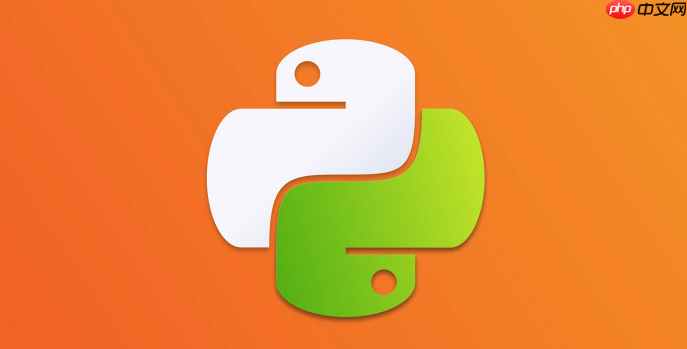将列表转换为字符串需用join()方法,确保元素均为字符串类型;含非字符串元素时应先用列表推导式结合str()转换。

在Python中,将列表转换为字符串最常见且高效的方式是使用字符串的
join()
split()
list()
将列表转换为字符串,核心在于使用
str.join(iterable)
# 示例1:基本用法,用逗号和空格连接
my_list = ['apple', 'banana', 'cherry']
result_string = ', '.join(my_list)
print(f"用', '连接: '{result_string}'") # 输出: 'apple, banana, cherry'
# 示例2:没有分隔符,直接连接
my_list_no_sep = ['P', 'y', 't', 'h', 'o', 'n']
result_string_no_sep = ''.join(my_list_no_sep)
print(f"用''连接: '{result_string_no_sep}'") # 输出: 'Python'
# 示例3:连接数字列表(需要先转换为字符串)
numbers = [1, 2, 3, 4, 5]
# 错误示范:直接join会报错 TypeError
# result_string_error = '-'.join(numbers)
# 正确做法:使用列表推导式将数字转换为字符串
result_string_numbers = '-'.join([str(num) for num in numbers])
print(f"连接数字列表: '{result_string_numbers}'") # 输出: '1-2-3-4-5'join()
s += item
将字符串转换为列表,主要有以下几种方法,具体取决于你想要如何分割字符串:
立即学习“Python免费学习笔记(深入)”;
str.split(separator)
# 示例1:按逗号和空格分割
my_string = 'apple, banana, cherry'
result_list = my_string.split(', ')
print(f"按', '分割: {result_list}") # 输出: ['apple', 'banana', 'cherry']
# 示例2:按单个字符分割
another_string = 'Python-is-fun'
result_list_dash = another_string.split('-')
print(f"按'-'分割: {result_list_dash}") # 输出: ['Python', 'is', 'fun']
# 示例3:不提供分隔符(默认按任意空白字符分割,并忽略连续空白)
whitespace_string = ' hello world python '
result_list_whitespace = whitespace_string.split()
print(f"按空白字符分割: {result_list_whitespace}") # 输出: ['hello', 'world', 'python']
# 示例4:限制分割次数
limited_split = "a-b-c-d-e"
result_limited = limited_split.split('-', 2) # 只分割前两次
print(f"限制分割次数: {result_limited}") # 输出: ['a', 'b', 'c-d-e']list(string)
list()
my_string_chars = 'Hello'
result_char_list = list(my_string_chars)
print(f"转换为字符列表: {result_char_list}") # 输出: ['H', 'e', 'l', 'l', 'o']列表推导式结合类型转换:处理包含数字的字符串 当字符串是由数字(或其他需要转换的类型)组成,并且你需要将它们转换为对应的数值类型时,通常会结合
split()
numbers_string = "10,20,30,40"
# 先分割得到字符串列表,再转换为整数列表
int_list = [int(num) for num in numbers_string.split(',')]
print(f"字符串数字转换为整数列表: {int_list}") # 输出: [10, 20, 30, 40]
float_string = "3.14 2.71 1.618"
float_list = [float(f) for f in float_string.split()]
print(f"字符串浮点数转换为浮点数列表: {float_list}") # 输出: [3.14, 2.71, 1.618]将列表转换为字符串时,最常见的陷阱莫过于列表里包含了非字符串类型的元素。
str.join()
None
TypeError
mixed_list = ['hello', 123, True, None, 3.14] # 尝试直接连接会报错 # result = ','.join(mixed_list) # TypeError: sequence item 1: expected str instance, int found
最佳实践和解决方案:
遇到这种情况,最佳实践是显式地将所有非字符串元素转换为字符串。这通常通过列表推导式结合
str()
使用列表推导式进行类型转换: 这是最Pythonic和推荐的做法。它清晰地表达了你的意图:将列表中的每个元素都转换为其字符串表示形式,然后再进行连接。
mixed_list = ['hello', 123, True, None, 3.14, ['nested']]
converted_string = ', '.join([str(item) for item in mixed_list])
print(f"转换后的字符串: '{converted_string}'")
# 输出: 'hello, 123, True, None, 3.14, ['nested']'这里
str()
__str__
__repr__
考虑数据清洗或验证: 在某些情况下,列表里出现非字符串元素可能不是预期行为,而是一个数据质量问题。在这种情况下,仅仅将其转换为字符串并连接起来可能只是治标不治本。你可能需要:
例如,如果你只想要数字:
data_points = ['temp', 25, 'humidity', 60, 'pressure', 1012.5, 'error']
numeric_values = [str(item) for item in data_points if isinstance(item, (int, float))]
result = '-'.join(numeric_values)
print(f"只连接数字: '{result}'") # 输出: '25-60-1012.5'记住,
join()
Python的
str.split()
split()
例如:
"apple,banana;cherry|date"
"item1 item2,item3; item4"
解决方案:
处理多分隔符字符串,主要有两种高效的方法:
链式 replace()
split()
str.replace()
split()
data_string = "apple,banana;cherry|date"
# 将所有分隔符统一替换为逗号
unified_string = data_string.replace(';', ',').replace('|', ',')
result_list = unified_string.split(',')
print(f"链式replace后分割: {result_list}") # 输出: ['apple', 'banana', 'cherry', 'date']
# 处理有空格和多种分隔符的情况
complex_string = "item1 item2, item3;item4 | item5"
# 先统一替换为单个空格,然后按空格分割(split()无参数会处理多个空格)
temp_string = complex_string.replace(',', ' ').replace(';', ' ').replace('|', ' ')
final_list = temp_string.split()
print(f"复杂字符串处理: {final_list}") # 输出: ['item1', 'item2', 'item3', 'item4', 'item5']这种方法直观易懂,对于少量分隔符非常有效。
使用正则表达式模块 re.split()
re
re.split()
import re
# 示例1:用逗号、分号或竖线作为分隔符
multi_delimiter_string = "apple,banana;cherry|date"
# r'[;,|]' 是一个正则表达式,表示匹配逗号、分号或竖线中的任意一个
result_list_re = re.split(r'[;,|]', multi_delimiter_string)
print(f"re.split处理多分隔符: {result_list_re}") # 输出: ['apple', 'banana', 'cherry', 'date']
# 示例2:处理包含多种空白字符和标点符号的情况
messy_string = "Word1 Word2, Word3; Word4.Word5"
# r'[\s,;.]+' 表示匹配一个或多个空白字符、逗号、分号或句点
result_list_messy = re.split(r'[\s,;.]+', messy_string)
# re.split 的一个特点是,如果分隔符在字符串的开头或结尾,或者有连续分隔符,可能会产生空字符串。
# 通常需要进一步过滤空字符串。
filtered_list_messy = [item for item in result_list_messy if item]
print(f"re.split处理复杂分隔符: {filtered_list_messy}") # 输出: ['Word1', 'Word2', 'Word3', 'Word4', 'Word5']
# 示例3:保留分隔符
# re.split 也可以通过在正则表达式中使用捕获组来保留分隔符
retained_split = re.split(r'(;)', "part1;part2;part3")
print(f"保留分隔符: {retained_split}") # 输出: ['part1', ';', 'part2', ';', 'part3']re.split()
replace()
re.split()
当我们将一个字符串(比如 CSV 行、日志条目或配置文件中的一行)通过
split()
int
float
例如,从
"10,20,30.5,40"
['10', '20', '30.5', '40']
[10, 20, 30.5, 40]
解决方案:
将字符串列表中的元素进行类型转换,最常用且高效的方法是结合列表推导式或map()
使用列表推导式进行类型转换: 列表推导式是Python中非常强大且简洁的构造,它允许你通过一个表达式来创建新的列表。
# 示例1:将字符串数字转换为整数
str_numbers = "10,20,30,40"
str_list = str_numbers.split(',')
int_list = [int(s) for s in str_list]
print(f"字符串列表转换为整数列表: {int_list}") # 输出: [10, 20, 30, 40]
# 示例2:将字符串数字转换为浮点数
str_floats = "3.14 2.718 1.618"
str_list_floats = str_floats.split() # 默认按空白字符分割
float_list = [float(s) for s in str_list_floats]
print(f"字符串列表转换为浮点数列表: {float_list}") # 输出: [3.14, 2.718, 1.618]列表推导式的好处在于其可读性和灵活性,你可以在其中加入条件判断 (
if
使用 map()
map()
map
# 示例1:使用 map() 转换为整数
str_numbers_map = "50,60,70"
int_list_map = list(map(int, str_numbers_map.split(',')))
print(f"map() 转换为整数列表: {int_list_map}") # 输出: [50, 60, 70]
# 示例2:使用 map() 转换为浮点数
str_floats_map = "9.8 10.2 11.5"
float_list_map = list(map(float, str_floats_map.split()))
print(f"map() 转换为浮点数列表: {float_list_map}") # 输出: [9.8, 10.2, 11.5]map()
处理转换错误(ValueError
int()
float()
ValueError
mixed_data = "10,20,invalid,30.5,error,40"
str_items = mixed_data.split(',')
# 方式一:在列表推导式中使用条件判断过滤
numeric_list_filtered = []
for s in str_items:
try:
# 尝试转换为整数,如果失败再尝试浮点数
if '.' in s: # 简单判断是否可能是浮点数
numeric_list_filtered.append(float(s))
else:
numeric_list_filtered.append(int(s))
except ValueError:
# 如果转换失败,可以选择跳过,或者用一个默认值
print(f"警告: '{s}' 无法转换为数字,已跳过。")
# numeric_list_filtered.append(None) # 或者添加None
pass
print(f"过滤非数字元素后的列表: {numeric_list_filtered}")
# 输出: 警告: 'invalid' 无法转换为数字,已跳过。
# 警告: 'error' 无法转换为数字,已跳过。
# 过滤非数字元素后的列表: [10, 20, 30.5, 40]
# 方式二:定义一个辅助函数,在map或列表推导式中使用
def try_convert_to_number(s):
try:
return int(s)
except ValueError:
try:
return float(s)
except ValueError:
return None # 或者你想要的任何默认值
converted_with_none = [try_convert_to_number(s) for s in str_items]
# 过滤掉 None 值
final_clean_list = [item for item in converted_with_none if item is not None]
print(f"使用辅助函数处理错误并清理: {final_clean_list}")
# 输出: 使用辅助函数处理错误并清理: [10, 以上就是python如何将列表转换为字符串_python列表与字符串相互转换技巧的详细内容,更多请关注php中文网其它相关文章!

python怎么学习?python怎么入门?python在哪学?python怎么学才快?不用担心,这里为大家提供了python速学教程(入门到精通),有需要的小伙伴保存下载就能学习啦!

Copyright 2014-2025 https://www.php.cn/ All Rights Reserved | php.cn | 湘ICP备2023035733号